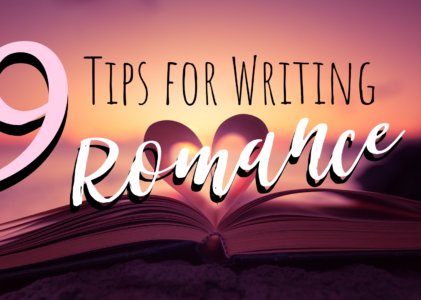February is here!!! And this means love’s in the air. Blue Raven Club is not the exception, and therefore, we’ll be having a series of blog posts devoted to one of the most popular and evergreen genres: Romance. So, do you like writing romance? making people’s hearts raise with the expectation of two souls gravitating towards each other? Well, if this is your case, stick around, this article is for you.
There’s nothing better than a good love story! I don’t care if it’s a book, a movie, or even a TV show, but there’s something magical about romance that I just can’t ignore.
Romance is a genre of success, and despite what many people think, writing romance is not easier than writing other genres. Every genre has its difficulties and romance is not the exception.
You see, there’s much more to a romance novel than having cute characters falling in love with each other. Romance, goes beyond making love or reciting Whitman’s poems on the porch. I want to feel there’s sacrifice, confidence, trust and putting the interests of another person before your own interests. And that’s when writing romance gets difficult.
What happens here is similar to what happens to science fiction and horror novels: people have written so much that sometimes it’s difficult to differentiate what should be done and what shouldn’t.
Like any other genre, romance has some basic structure requirements like developed, vivid characters; strong conflicts and real dialogues. The only thing that makes this genre different is that love is the main focus of the story. That doesn’t make it any worse or lower its quality.
My experience writing romance
As a YA Fantasy lover, I started writing stories about Katnisses and Harry Potters rather than Darcies and Elizabeths. I had the werewolf and the vampire stuck beneath my flesh. However, when I read my first romance novel everything changed. And, therefore, at the age of 17, I began writing about love, and not only magic.
My first romance attempt was everything but perfect or polished. It was the combination of all the possible mistakes a writer can make. This happens to many of us when we face a new genre, so don’t be afraid if this is your case. It can only turn you into a better writer if you decide to learn from them.
Tips for writing romance
If you are a romance fan like me, or you are just discovering this genre, read this post till the end to discover my tips to write the love story everybody wants to read!
I’ve got to say this is my personal opinion and these tips are based on my writing experience, yes; but more on my experience as a reader. This is what I expect from a love story and what I mainly enjoy reading.
1. Read Romance

One of the best tips to become a better writer is reading other people’s work. Same thing happens here. Reading romance is the best way to get to know the genre and its different subgenres. Also, you get an idea of what definitely works and what doesn’t work so much.
I’ve met people who think they can write romantic novels without having read a single one in their entire life. I find that if you are not interested in it as a reader, it will be very difficult for you to write a good love story.
Having said that, I suggest you focus on the subgenre you are writing and learn from the best authors. Read like a writer. Study how they make you laugh and cry. If there’s something you like, go back and re-read it, identify the elements you like, and try to apply them in your story.
2. Select your Subgenre
Romance is a wide genre, and therefore, it comprises numerous subgenres. This means that you need to be clear about the kind of romance you want your story to be. Every romance subgenre has its own characteristics and distinctive features.
Selecting your subgenre is vital, because it’ll determine key aspects that you need to take into account to make your story more believable to the reader’s eyes. Romance can be subdivided into:
- Contemporary: this kind of romance is portrayed in the present and features modern conventions as well as a different and unconventional approach. Some of its topics are LGBTQ, and empowered heroines who break the mold.
- Historical: placed and developed during a specific period of time, before 1945. It’s distinctive of this subgenre the attention to the details and the limitations of the era where the story is developed (if you are writing a Regency romance your characters cannot have internet, phones or modern names).
- Spiritual/Christian: this kind of romance is characterized by the use of spiritual or Christian elements, and therefore faith plays a major role. Romance is portrayed in a more pure and conservative way.
- Romantic Suspense: this subgenre features two powerful ingredients; romance and suspense. It features action, drama, mystery, and romance. A good novel within the genre combines the pacing of mystery with the development of the main love story. So that when you finish the book, the mystery is solved and the relationship between your main characters has evolved.
- Speculative Romance: includes subcategories like Paranormal and romantic fantasy. It features magical and supernatural elements like time-traveling or vampires. In this subgenre, worldbuilding is also important.
- YA Romance: features love stories where the main characters are young people. This type of story is geared towards teenagers, and it explores topics related to them.
If you are into ghosts you can write paranormal romance; if your interest is fantastic creatures you can give romantic fantasy a try. Perhaps you are passionate about a certain period of time, and then historical romance is for you.
Whether you are writing contemporary, YA, inspirational, or historical romance you need to read books within your subgenre to get an overview of your niche and to get ideas for your own book.
3. Nail your Meet-Cute
If you are not sure of what the meet-cute is, or this is the first time you see these words, don’t worry; I’ll explain it to you. The meet-cute of your story is basically when your main characters meet for the first time. But, this actually goes beyond that. It’s showing that they two will end up together, and making your readers actually root for that.

Your meet cute, therefore, is a big deal. We are curious and love interesting “how did you guys meet?” stories, and you, as a writer, need to take advantage of that. You need to ask yourself these questions:
- How do they meet? Through a friend? Coincidentally? Because of a sprained ankle (you’ll be surprised how many 18th century meet-cutes happened because of a twisted ankle)?
- What’s their first impression? (Establishing the status-quo) Do they like each other? Is it awkward? Do they clash? Why?
- How do they feel after leaving? Are they nervous? Confused? Angry? Excited?
The following is an example from The Fault is in our Stars by John Green:
A boy was staring at me.
I was quite sure I’d never seen him before. Long and leanly muscular, he dwarfed the molded plastic elementary school chair he was sitting in. Mahogany hair, straight and short. He looked my age, maybe a year older, and he sat with his tailbone against the edge of the chair, his posture aggressively poor, one hand half in a pocket of dark jeans.
I looked away, suddenly conscious of my myriad insufficiencies. (…) And yet—I cut a glance to him, and his eyes were still on me.
(…)
Finally, I decided that the proper strategy was to stare back. Boys do not have a monopoly on the Staring Business, after all. So I looked him over as Patrick acknowledged for the thousandth time his ball-lessness etc., and soon it was a staring contest. After a while the boy smiled, and then finally his blue eyes glanced away. When he looked back at me, I flicked my eyebrows up to say, I win.
John Green
4. Avoid Clichés
One misconception among people who don’t like romance is that all romance novels are the same. That, of course, is a complete lie. Every romance story is different though sometimes we can find clichés that might make us walk apart. When I say cliché I make reference to all the types and forms of it. If you want your romance novel to outstand and to be unique, you really need to stay away from clichés.
First of all, avoid clichéd romance phrases. Instead, look for a way to say it differently, or even better, find a way to make your character say it differently. So, forget about “sending daggers her way” and “hands tangling in his hair”, not to mention hearts “skipping a beat”, or ridiculous sexual phrases and names for body parts. Be yourself and use your own words, or the actual words, if it’s the case.
Also, try not to fall into clichéd plot elements like bad boy gets good girl, and man/woman-haters that swear not to love again, yet they manage to get a lover within the next 10 pages without getting therapy. They are, at first, inconsistent and have been overused. If you want to use them somehow, why not subvert them? You can keep some elements and then give your plot an unexpected twist to surprise your readers.
Last but not least, avoid clichéd character archetypes. In real life, love is anything but perfect. So, don’t try to make a perfect love story, but a believable one. Surprise your readers with out-of-the-mold characters. Try to change conventional roles or expectations: what if she is the one who leaves and goes to war? Or what if he is a vulnerable man? or what if we get out of the heterosexual mold a little bit more? Giving your story a twist like this will instantly make it different.
5. Focus on Romance

Everything that you are going to write in your novel has the purpose of developing a romantic story and it should respond to that. For instance, if your main character is an insecure woman who doesn’t believe in love because her father walked out on her when she was a little girl, it’s ok. As I said before, our characters are not perfect and they shouldn’t be. However, the way you help her overcome this situation must be developed in a way that is related to her romantic interest. Don’t have her father being the main focus of your romance novel, because that’s not relevant to the love story and will deviate the attention to a secondary character, which is not our intention.
Be careful not to let your romantic story in a second plane if you decide to write any of the subgenres we mentioned previously. If your meet cute is on page 60, your readers will probably lose interest by then.
Remember to center the story in your protagonists and their relationship. The rest of the characters and situations are just means to create a more realistic love story, but giving them too much attention can affect your plot.
6. Build up the Tension between the Characters
Sensual tension is a key aspect of relationships and therefore, an important part of romance novels. It’s what keeps your readers craving for more and more. In real life, you first have a physical attraction, then fall in love for a person. This tension should exist from the first moment they meet and keep going up as their relationship develops (not necessarily meaning they’ll need to end up having sex).
Sensual tension is a must if you want readers to get to the happily-ever-after part. You can craft complete characters, have an amazing plot, and an incredible meet cute; if there’s not sensual tension, readers won’t bother turning the page.
Something commonly misunderstood, is that sensual tension equals sex, which it’s not true. It’s actually what happens before that. It’s the attraction, the anticipation, and the awareness.
There are many degrees of sensual tension, and it ranges from pure and sweet to erotic. Just be comfortable with what you are writing and you’ll convey what you want. You need to find the perfect balance between your scenes, that’s what makes the difference between erotic and romantic. It’s not good giving too little, but it can be worse to give too much.
Need tips on how to be a better writer? Click here!
7. Avoid Unhealthy Tropes

Never, ever, portray an abusive story as a romance story. Perhaps you are thinking I went nuts, but the truth is that I’ve found stories that pass off unhealthy relationships as romantic stories.
Avoid all that “He is jealous because he loves me so much he can’t live with the idea of losing me”. That’s not love, and that’s not healthy. Don’t make your characters justify any kind of abuse. Love should be healthy. And that’s what you need to convey.
Many people read romance novels as a way to learn about love. They want to be like your hero or your heroine and they root for a happy ending like theirs. Maybe they don’t have much experience, and they rely on their favorite books to think about how things in a relationship should be. If you show that abuse can be love, they’ll assume that’s true, because that’s what they’ve read, and they’ll just pass it off as the other person “loving them too much”.
8. Make your Characters Complete People
You need your readers to think they are real people whose main purpose in life is not only to be a love interest. As I said before readers want three-dimensional characters and real love stories. After all, even when you are writing romance, the romance needs to happen between real people.
So, how do you know if you have a shallow character that was born just to be a love interest? Well, mainly if that character is passive and everything in their life is related to the other character. We don’t want satellite characters that are only defined by their love for the other character. We want complete and compelling characters that can fall in love.
The first example that comes to my mind is Bella from Twillight by Stephenie Meyer. It seems like we don’t know too much about her life in Phoenix, and everything in her life seems to be related to being Edward’s girlfriend. Not to mention the “imprinting” thing, which I find kind of creepy, by the way. Again, just my opinion.
If you want to avoid this, think about who they are and what they do when they are not with the other person: where do they come from? What are they passionate about? Do they have dreams?
If you need more help, check this post to learn everything you need to know about characters and get our FREE character sheet to craft them!
9. Balance their Relationship
When you are writing romance, each of your main characters should bring the same to the relationship. Not only one of them should be saved, they should equally contribute to each other, that’s why they call it a partnership after all.
We want to see a relationship between two people, not one person deciding and doing everything and the other being simply “there”. That’s boring, and relationships are not like that. Both of your characters need to complement each other. This means that you can make one of them be very vulnerable, while the other can be stronger, or maybe one is a dreamer, whereas the other is more down-to-earth. Make sure they find just what they were lacking of.
Also, give them the chance to see each other’s vulnerability and to look after, or protect the other. These are the things that will make possible to see an evolution in their relationship and will make their feelings more believable to the readers’ eye.
Summing up…
Writing romance can be sometimes tricky, but if you take care of the things we listed before, you’ll probably end up having a story that will make your readers swoon.
I hope you find these tips useful and that you put them into practice in your future projects. Do you have a favorite romance novel? Has any story made you swoon? Let us know in the comments.


